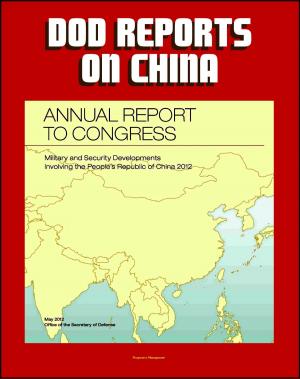The Archer's Tale: An Examination of English Archers During the Hundred Years War and Their Impact on Warfare and Society - Medieval England's Use of Large Infantry Formations with Longbows
Nonfiction, History, Military, Weapons, Medieval| Author: | Progressive Management | ISBN: | 9781370972487 |
| Publisher: | Progressive Management | Publication: | January 26, 2017 |
| Imprint: | Smashwords Edition | Language: | English |
| Author: | Progressive Management |
| ISBN: | 9781370972487 |
| Publisher: | Progressive Management |
| Publication: | January 26, 2017 |
| Imprint: | Smashwords Edition |
| Language: | English |
This excellent report has been professionally converted for accurate flowing-text e-book format reproduction. Much of England's success in the Hundred Years War is attributed to England's use of large infantry formations made up of commoners armed with the longbow. A variety of factors including the Black Death and the amalgamation of several cultures, created a society in England with a relatively high degree of social mobility. The demands of war against a much larger opponent combined with England's relative social mobility made it possible for England to incorporate low born archers into their professional military community which previously only included the aristocracy and the gentry. The success of these common archers on the battlefield continued to increase the level of social mobility available to low born men. English "Yeoman Archers," as they came to be known, became the embodiment of a new social order in which ability was more prized than birth. They had a dramatic impact on the character of warfare in the fourteenth century and the development of the western way of war as we know it today.
CHAPTER 1 - THE ARCHER'S TALE * CHAPTER 2 - ENGLISH SOCIETY IN THE FOURTEENTH CENTURY * The Three Estates of Man and the Feudalism. The Realities of English Society * Wealth and Social Mobility * Government * English National Identity * Plague and War in the Fourteenth Century * The Plague * The Hundred Years War * CHAPTER 3 - THE ENGLISH MILITARY COMMUNITY OF THE LATTER FOURTEENTH CENTURY * The Social and Economic Realities of the English Military Situation in the Fourteenth Century * Training * Why Join the Army? * Conclusion * CHAPTER 4 - THE ENGLISH ARCHER * The Yeoman Archer * Hunting in the King's Forest * Outlaws, the Robin Hood Legend, and Royal Pardons * Conclusion * CHAPTER 5 - THE ARCHER'S IMPACT ON WARFARE AND SOCIETY * CHAPTER 6 - CONCLUSION * BIBLIOGRAPHY
In order to understand the archer's place in society one must first have some understanding of society as a whole. Therefore, chapter 2 begins with a brief discussion of English society in the fourteenth century. This discussion addresses how English society tried to define itself utilizing the three estates, and how the realities of English society differed from this idealized model. Additionally, there is a brief examination of the major events that shaped the fourteenth century.
Chapter 3 narrows the focus to examine the English military community of the fourteenth century. It is necessary to discuss the structure of the military community and the social aspects that determined who served as a man-at-arms and who served as an archer. It will also be necessary to examine the social and military realities of the English position at the beginning of the Hundred Years War that necessitated their reliance on archers. These discussions will establish a firm understanding of English society and the English military community and allow for a more detailed analysis of the social status of English archers.
The fourth chapter examines the social status of English archers as well as the specific aspects of English culture that allowed England to create a massed archery capability when no other western monarchy could. This study will conclude with an examination of the archer's impact on the western way of war and English society.
This excellent report has been professionally converted for accurate flowing-text e-book format reproduction. Much of England's success in the Hundred Years War is attributed to England's use of large infantry formations made up of commoners armed with the longbow. A variety of factors including the Black Death and the amalgamation of several cultures, created a society in England with a relatively high degree of social mobility. The demands of war against a much larger opponent combined with England's relative social mobility made it possible for England to incorporate low born archers into their professional military community which previously only included the aristocracy and the gentry. The success of these common archers on the battlefield continued to increase the level of social mobility available to low born men. English "Yeoman Archers," as they came to be known, became the embodiment of a new social order in which ability was more prized than birth. They had a dramatic impact on the character of warfare in the fourteenth century and the development of the western way of war as we know it today.
CHAPTER 1 - THE ARCHER'S TALE * CHAPTER 2 - ENGLISH SOCIETY IN THE FOURTEENTH CENTURY * The Three Estates of Man and the Feudalism. The Realities of English Society * Wealth and Social Mobility * Government * English National Identity * Plague and War in the Fourteenth Century * The Plague * The Hundred Years War * CHAPTER 3 - THE ENGLISH MILITARY COMMUNITY OF THE LATTER FOURTEENTH CENTURY * The Social and Economic Realities of the English Military Situation in the Fourteenth Century * Training * Why Join the Army? * Conclusion * CHAPTER 4 - THE ENGLISH ARCHER * The Yeoman Archer * Hunting in the King's Forest * Outlaws, the Robin Hood Legend, and Royal Pardons * Conclusion * CHAPTER 5 - THE ARCHER'S IMPACT ON WARFARE AND SOCIETY * CHAPTER 6 - CONCLUSION * BIBLIOGRAPHY
In order to understand the archer's place in society one must first have some understanding of society as a whole. Therefore, chapter 2 begins with a brief discussion of English society in the fourteenth century. This discussion addresses how English society tried to define itself utilizing the three estates, and how the realities of English society differed from this idealized model. Additionally, there is a brief examination of the major events that shaped the fourteenth century.
Chapter 3 narrows the focus to examine the English military community of the fourteenth century. It is necessary to discuss the structure of the military community and the social aspects that determined who served as a man-at-arms and who served as an archer. It will also be necessary to examine the social and military realities of the English position at the beginning of the Hundred Years War that necessitated their reliance on archers. These discussions will establish a firm understanding of English society and the English military community and allow for a more detailed analysis of the social status of English archers.
The fourth chapter examines the social status of English archers as well as the specific aspects of English culture that allowed England to create a massed archery capability when no other western monarchy could. This study will conclude with an examination of the archer's impact on the western way of war and English society.















